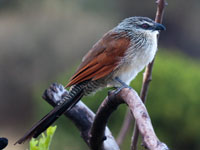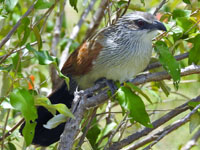The cuckoo family Cuculidae contains six subfamilies. The first three listed below are found in the New world, while the remaining three are found in the Old World.
* Coccyzinae – New World Cuckoos
* Neomorphinae – New World Ground Cuckoos
* Crotophaginae – Anis
* Cuculinae – Old World Cuckoos
* Phaenicophaeinae – Malkohas and Couas
* Centropodinae – Coucals
This article is about the Centropodinae subfamily that contains the coucals. Some suggest that the coucals should be a family, not a subfamily. The coucals are not brood parasites; that is, they lay their eggs in their own nests and raise their chicks. These nests are constructed in dense vegetation and usually have the top closed. Coucals are found in Africa, Asia, and Australasia.
The plumage of the males and female are the same. Contrary to most species of birds, the females of this subfamily are larger than the males and the males provide most of the care of the chicks.
Many coucals have a long claw on their hind toe. Most coucals have brown or chestnut wings and many have a black head and underparts. They eat insects including caterpillars and grasshopper, spiders, snails, frogs, small snakes, mice, crustaceans, small birds. Most forage stealthily in dense vegetation and are thus hard to observed.
The cuckoo family Cuculidae
The cuckoo family Cuculidae is the only family of the order Cuculiformes. The family is represented on all continents except Antarctica. Most species reside in tropical or subtropical environments. Those in temperate locations migrate to avoid cool or cold winters. In addition to cuckoos, the family Cuculidae also includes the roadrunners, koels, malkohas, couas, coucals and anis. The coucals and anis are sometimes separated as distinct families. The cuckoos are generally medium sized slender birds. The majority are of the cuculidae family are arboreal, with a sizeable minority that is terrestrial.
Cuckoos are medium sized birds that range in size from 15-63 cm. There is generally little sexual dimorphism in size, but where it exists, it can be either the male or the female that is larger, depending on the genera. There are two basic body forms, arboreal species which are slender and terrestrial species which are more heavy set and have stronger legs. Almost all species have long tails which are used for steering in terrestrial species and as a rudder during flight in the arboreal species.
Many species are brood parasites, laying their eggs in the nests of other species, but the majority of species raise their own young. The brood parasitic birds usually only parasitize a single host species or a small group of closely related host species. They tend to remove a host egg when they lay one of their own in a nest. This both prevents the host species from realizing their nest has been parasitized and reduces food competition for the parasitic nestling once it hatches. Some brood parasites will eliminate all their nest-mates shortly after hatching. If the host removes a parasitic egg or chick, the adult parasitic birds may retaliate by destroying the nest.
There has been an evolutionary arms race between the cuckoos that leave their eggs in other nests, and the hosts that get these unwanted presents. The cuckoos have evolved to be able to lay their eggs faster than most other species and the eggs need less incubation time before hatching. These eggs often resemble the host eggs to prevent detection of an invader egg. The drongo-cuckoos resemble their host. Some hosts have evolve to be social so the colony can be on the lookout for an invader trying to deposit an egg. Others have more than one brood of chicks per year so there will be replacements for any losses due to cuckoos.
Cuckoos feed on insects, small animals, seeds, and fruit. For many cuckoo species, caterpillars are their favorite food; even hairy caterpillars that are avoided by most other birds. Cuckoos can consume hairy caterpillars because of their ability to shed their abdominal lining and get rid of the hairs via a pellet. Another favorite food of many cuckoos are grasshoppers. We may find it repugnant that some cuckooos are brood parasitic and they or their offspring even kill the host's chicks, but on the plus side cuckoos help prevent plagues of caterpillars and grasshoppers!
Almost all cuckoos are shy which can make them a challenge to observe and photograph. Consistent with this behavior, they are not colonial breeders. These traits may be have their roots in their brood parasitic behavior. Stealth is a good characteristic if you want to sneak an egg into a host's nest.
* Coccyzinae – New World Cuckoos
* Neomorphinae – New World Ground Cuckoos
* Crotophaginae – Anis
* Cuculinae – Old World Cuckoos
* Phaenicophaeinae – Malkohas and Couas
* Centropodinae – Coucals
This article is about the Centropodinae subfamily that contains the coucals. Some suggest that the coucals should be a family, not a subfamily. The coucals are not brood parasites; that is, they lay their eggs in their own nests and raise their chicks. These nests are constructed in dense vegetation and usually have the top closed. Coucals are found in Africa, Asia, and Australasia.
The plumage of the males and female are the same. Contrary to most species of birds, the females of this subfamily are larger than the males and the males provide most of the care of the chicks.
Many coucals have a long claw on their hind toe. Most coucals have brown or chestnut wings and many have a black head and underparts. They eat insects including caterpillars and grasshopper, spiders, snails, frogs, small snakes, mice, crustaceans, small birds. Most forage stealthily in dense vegetation and are thus hard to observed.
The cuckoo family Cuculidae
The cuckoo family Cuculidae is the only family of the order Cuculiformes. The family is represented on all continents except Antarctica. Most species reside in tropical or subtropical environments. Those in temperate locations migrate to avoid cool or cold winters. In addition to cuckoos, the family Cuculidae also includes the roadrunners, koels, malkohas, couas, coucals and anis. The coucals and anis are sometimes separated as distinct families. The cuckoos are generally medium sized slender birds. The majority are of the cuculidae family are arboreal, with a sizeable minority that is terrestrial.
Cuckoos are medium sized birds that range in size from 15-63 cm. There is generally little sexual dimorphism in size, but where it exists, it can be either the male or the female that is larger, depending on the genera. There are two basic body forms, arboreal species which are slender and terrestrial species which are more heavy set and have stronger legs. Almost all species have long tails which are used for steering in terrestrial species and as a rudder during flight in the arboreal species.
Many species are brood parasites, laying their eggs in the nests of other species, but the majority of species raise their own young. The brood parasitic birds usually only parasitize a single host species or a small group of closely related host species. They tend to remove a host egg when they lay one of their own in a nest. This both prevents the host species from realizing their nest has been parasitized and reduces food competition for the parasitic nestling once it hatches. Some brood parasites will eliminate all their nest-mates shortly after hatching. If the host removes a parasitic egg or chick, the adult parasitic birds may retaliate by destroying the nest.
There has been an evolutionary arms race between the cuckoos that leave their eggs in other nests, and the hosts that get these unwanted presents. The cuckoos have evolved to be able to lay their eggs faster than most other species and the eggs need less incubation time before hatching. These eggs often resemble the host eggs to prevent detection of an invader egg. The drongo-cuckoos resemble their host. Some hosts have evolve to be social so the colony can be on the lookout for an invader trying to deposit an egg. Others have more than one brood of chicks per year so there will be replacements for any losses due to cuckoos.
Cuckoos feed on insects, small animals, seeds, and fruit. For many cuckoo species, caterpillars are their favorite food; even hairy caterpillars that are avoided by most other birds. Cuckoos can consume hairy caterpillars because of their ability to shed their abdominal lining and get rid of the hairs via a pellet. Another favorite food of many cuckoos are grasshoppers. We may find it repugnant that some cuckooos are brood parasitic and they or their offspring even kill the host's chicks, but on the plus side cuckoos help prevent plagues of caterpillars and grasshoppers!
Almost all cuckoos are shy which can make them a challenge to observe and photograph. Consistent with this behavior, they are not colonial breeders. These traits may be have their roots in their brood parasitic behavior. Stealth is a good characteristic if you want to sneak an egg into a host's nest.
Cuckoo family members are zygodactyl: they have the 2 inner toes facing forward and 2 two outer toes facing to the rear.
Coucals
Genus Centropus
The coucals are not brood parasites. The smaller male provides most of the parental care. Many coucals have a long claw on their hind toe.
Coucal,_Andaman Centropus andamanensis
Description: The Andaman coucal has greyish brown head, mantle, and underparts. The lower back is chestnut. The tail varies from brown at the base to dark purple-brown at the tip.
Range: Andaman Islands (west of Myanmar in Indian Ocean).
Habitat: Forested habitats and disturbed areas such as gardens.
Diet: Insects, small frogs, crabs and lizards.
Conservation status: Least concern.
Image by: 1) Antony_Grossy 2) Albinjacob 3) TR Raman Range: Andaman Islands (west of Myanmar in Indian Ocean).
Habitat: Forested habitats and disturbed areas such as gardens.
Diet: Insects, small frogs, crabs and lizards.
Conservation status: Least concern.
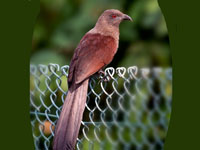

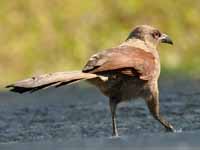
Coucal,_Bay Centropus celebensis
Description: The bay coucal has a grey crown. The wings and tail are dark chestnut (that is, bay) while the rest of the plumage is light chestnut. The bill and feet are black.
Range: Indonesia.
Habitat: Subtropical or tropical forests. It is mainly arboreal.
Diet: Large insects, beetles, spiders.
Conservation status: Least concern.
Image by:
1) AS_KonoRange: Indonesia.
Habitat: Subtropical or tropical forests. It is mainly arboreal.
Diet: Large insects, beetles, spiders.
Conservation status: Least concern.
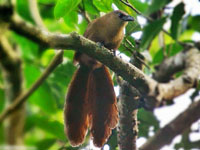
Coucal,_Biak Centropus chalybeus
Description: The Biak coucal has black plumage. The bill is black and the eyes are yellow.
Range: Biak Island of New Guinea.
Habitat: Lowland forest.
Conservation status: It is near threatened by habitat loss.
No public domain images available.Range: Biak Island of New Guinea.
Habitat: Lowland forest.
Conservation status: It is near threatened by habitat loss.
Coucal,_Black Centropus grillii
Description: During breed season the black coucal is all black except for brown wings. At other times it has dark brown upperparts with rufous barring.
Range: Sub-Saharan Africa.
Habitat: Open areas such as grasslands.
Diet: Insects, especially grasshoppers. Also siders, beetles, small reptiles.
Conservation status: Least concern.
Image by: 1, 2, 4) Nik_Borrow - Uganda, Guinea 3) Darren Bellerby - Maasai Mara, Kenya Range: Sub-Saharan Africa.
Habitat: Open areas such as grasslands.
Diet: Insects, especially grasshoppers. Also siders, beetles, small reptiles.
Conservation status: Least concern.
1, 2) nonbreeding
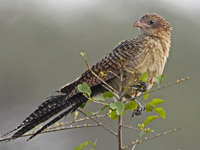
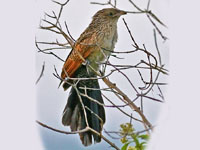
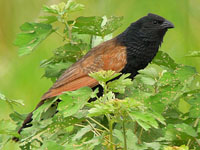
Coucal,_Black-faced Centropus melanops
Description: The black-faced coucal has a black face. It has pale buff neck and upper-breast while the lower-breast and belly are black. The wings and tail are brown and the eyes are red.
Range: Philippines.
Habitat: Forests.
Conservation status: Least concern.
Image by: 1) Brendan_RyanRange: Philippines.
Habitat: Forests.
Conservation status: Least concern.
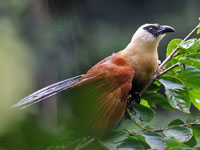
Coucal,_Black-hooded Centropus steerii
Description: During breed season the black coucal is all black except for brown wings. At other times it has dark brown upperparts with rufous barring.
Range: Sub-Saharan Africa.
Habitat: Open areas such as grasslands.
Diet: Insects, especially grasshoppers. Also spiders, beetles, small reptiles.
Conservation status: Least concern.
No public domain images available.Range: Sub-Saharan Africa.
Habitat: Open areas such as grasslands.
Diet: Insects, especially grasshoppers. Also spiders, beetles, small reptiles.
Conservation status: Least concern.
Coucal,_Black-throated Centropus leucogaster
Description: The black-throated coucal has a black head, throat, upper-breast, upper-mantle, and tail. The eyes are red and the bill is black. The wings are rufous-chestnut and the thighs, flanks, and under-tail are rufous tinged. The lower-breast and belly are whitish.
Range: West Africa.
Habitat: Forest edges and open areas such as grassland.
Diet: Insects, spiders, frogs.
Conservation status: Least concern.
Image by: 1) Nik_Borrow - GhanaRange: West Africa.
Habitat: Forest edges and open areas such as grassland.
Diet: Insects, spiders, frogs.
Conservation status: Least concern.
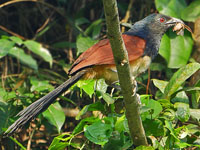
Coucal,_Blue-headed Centropus monachus
Description: The blue-headed coucal has black head, nape, and upper-breast all of which have a blue gloss. The wings are deep chestnut and the tail is black. The underparts are white or pale. The bill is black and the feet are dark.
Range: Central Africa.
Habitat: It is not fussy where it lives. Found in forests, swamps, grasslands, villages.
Diet: It is not a fussy eater either. It eats insects, snails, lizards, mice, birds, and more.
Conservation status: Least concern.
Image by: 1, 2, 3) Nik Borrow - Uganda, Ghana, CameroonRange: Central Africa.
Habitat: It is not fussy where it lives. Found in forests, swamps, grasslands, villages.
Diet: It is not a fussy eater either. It eats insects, snails, lizards, mice, birds, and more.
Conservation status: Least concern.
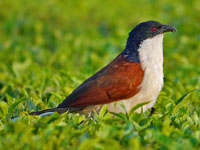

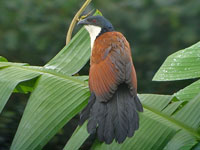
Coucal,_Buff-headed Centropus milo
Description: The buff-headed coucal has a buff head, upper-back, and also the underparts are buff.The rest of the plumage is black. The eyes are red. It is a large coucal with a heavy dark grey bill and short wings. The legs are also grey.
Range: Solomon Islands.
Habitat: Moist lowland and mountain forests.
Diet: Insects such as grasshoppers. Also beetles and centipedes.
Conservation status: Least concern.
Image by: 1) John GouldRange: Solomon Islands.
Habitat: Moist lowland and mountain forests.
Diet: Insects such as grasshoppers. Also beetles and centipedes.
Conservation status: Least concern.
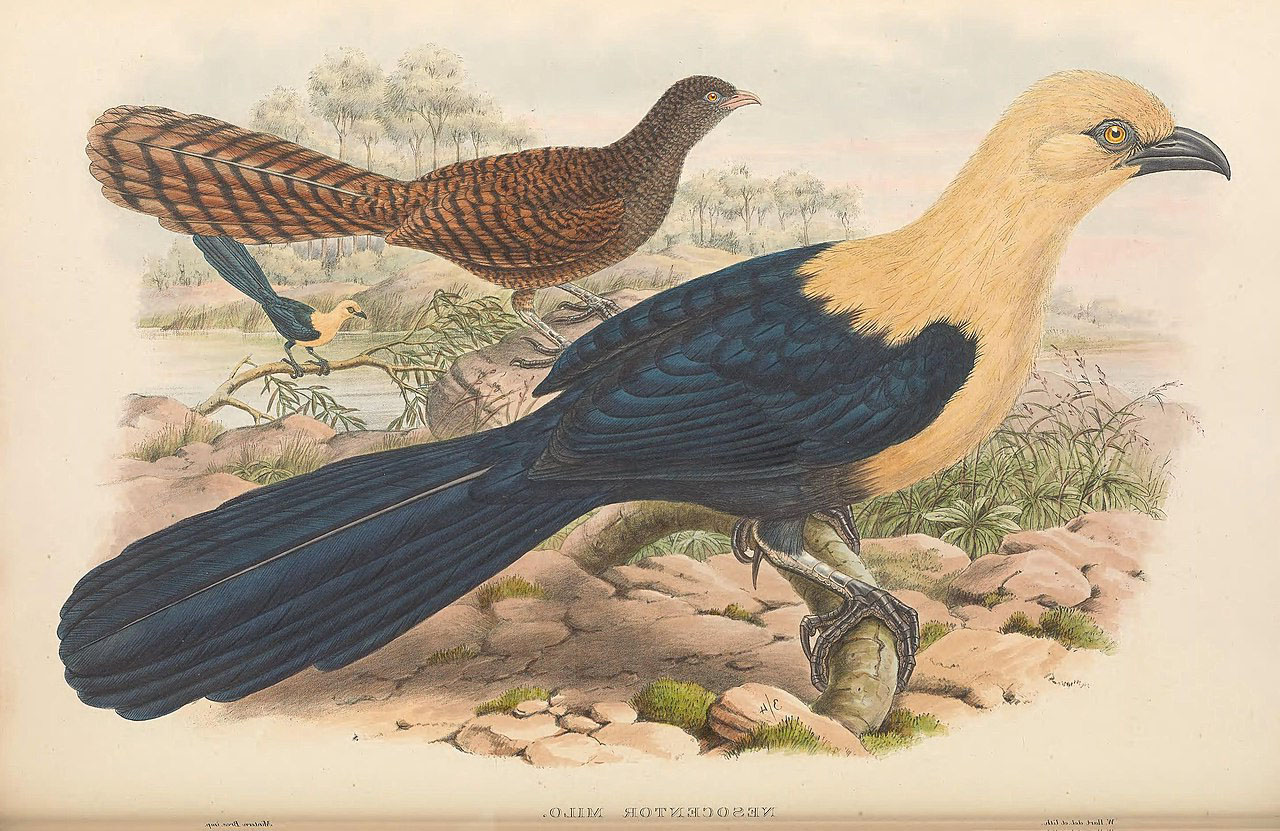
Coucal,_Burchell's Centropus burchelli Found: Africa
Description: The Burchell's coucal is often considered to be a subspecies of the white-browed coucal and is then assigned Centropus superciliosus burchelli. It has a black crown, nape, bill, feet, and tail. The back is rufous-brown and the wings are chestnut. It has a blackish rump. The underparts are creamy-white, the eyes are red.
Range: Sub-Saharan Africa.
Habitat: Areas with thick cover from undergrowth and scrub.
Diet: Insects such as grasshoppers; also lizards, small snakes, frogs, mice.
Conservation status: Least concern.
Image by: 1, 2) Derek_Keats - South Africa 3) Lip Kee - Botswana Range: Sub-Saharan Africa.
Habitat: Areas with thick cover from undergrowth and scrub.
Diet: Insects such as grasshoppers; also lizards, small snakes, frogs, mice.
Conservation status: Least concern.
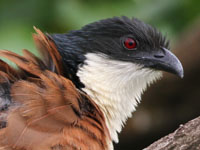
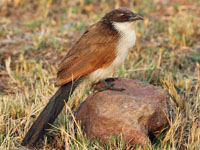

Coucal,_Coppery-tailed Centropus cupreicaudus
Description: The coppery-tailed coucal has black head, nape, and mantle. The rump is brown with a coppery gloss; and a brownish-black tail. The underparts are white or cream.
Range: South central Africa.
Habitat: Swampland and dense vegetation near rivers.
Diet: Insects, snails, frogs, fish, small animals.
Conservation status: Least concern.
Image by: 1, 2) Ian White - Zimbabwe 3) Frans_VandewalleRange: South central Africa.
Habitat: Swampland and dense vegetation near rivers.
Diet: Insects, snails, frogs, fish, small animals.
Conservation status: Least concern.
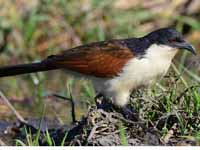

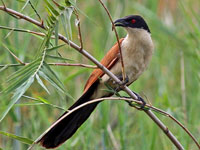
Coucal,_Gabon Centropus anselli
Description: The Gabon coucal has black glossed with purple back, head, and nape. The wings are dark brown. The lower back, rump, and underparts are buff. It has a black feet.
Range: Tropical west-central Africa.
Habitat: Forests, forest edges, swamps.
Diet: Grasshoppers, beetles, mollusks, frogs, birds, lizards, small snakes.
Conservation status: Least concern.
Image by:
1) John Gerrard Keulemans Range: Tropical west-central Africa.
Habitat: Forests, forest edges, swamps.
Diet: Grasshoppers, beetles, mollusks, frogs, birds, lizards, small snakes.
Conservation status: Least concern.
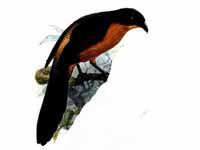
Coucal,_Goliath Centropus goliath
Description: The goliath coucal has black plumage except for a broad white patch on the wings. The feet and bill are black.
Range: Maluku Islands (Indonesia).
Habitat: Forests and surrounding areas.
Conservation status: Least concern.
Image by:
1) Paulo_Alves 2) Francesco VeronesiRange: Maluku Islands (Indonesia).
Habitat: Forests and surrounding areas.
Conservation status: Least concern.
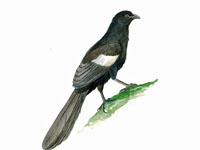
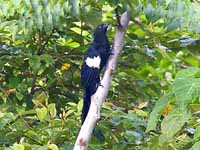
Coucal,_Greater also Crow Pheasant Centropus sinensis
Description: The greater coucal is a large species that has a chestnut brown back and wings. The head is black while the mantle and underparts are also black, but they are glossed with purple. It has red eyes.
Range: India, east to south China and Indonesia.
Habitat: Varies from jungle to cultivated land and urban gardens.
Diet: Insects including caterpillars; also small vertebrates, fruit, seeds.
Conservation status: Least concern.
Image by: 1) Shantanu_Kuveskar 2) Koshy_Koshy 3) Hafiz_Issadeen - Sri Lanka 4) Vijay_Ismavel - India 5) Imran_Shah - PakistanRange: India, east to south China and Indonesia.
Habitat: Varies from jungle to cultivated land and urban gardens.
Diet: Insects including caterpillars; also small vertebrates, fruit, seeds.
Conservation status: Least concern.
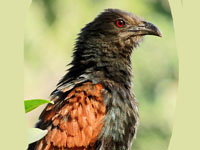

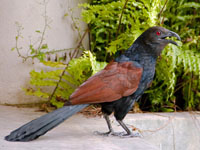


Coucal,_Greater_Black Centropus menbeki
Description: The greater black coucal, also known as the ivory-billed coucal, has black plumage, It is a large coucal with an ivory-colored bill. The eyes are red.
Range: The Aru Islands and New Guinea.
Habitat: Forest and scrub areas.
Diet: Insects such as caterpillars and grasshoppers, spiders, crustaceans, frogs, small snakes and birds.
Conservation status: Least concern.
Image by: 1) Katerina_Tvardikova 2) DuperreyRange: The Aru Islands and New Guinea.
Habitat: Forest and scrub areas.
Diet: Insects such as caterpillars and grasshoppers, spiders, crustaceans, frogs, small snakes and birds.
Conservation status: Least concern.

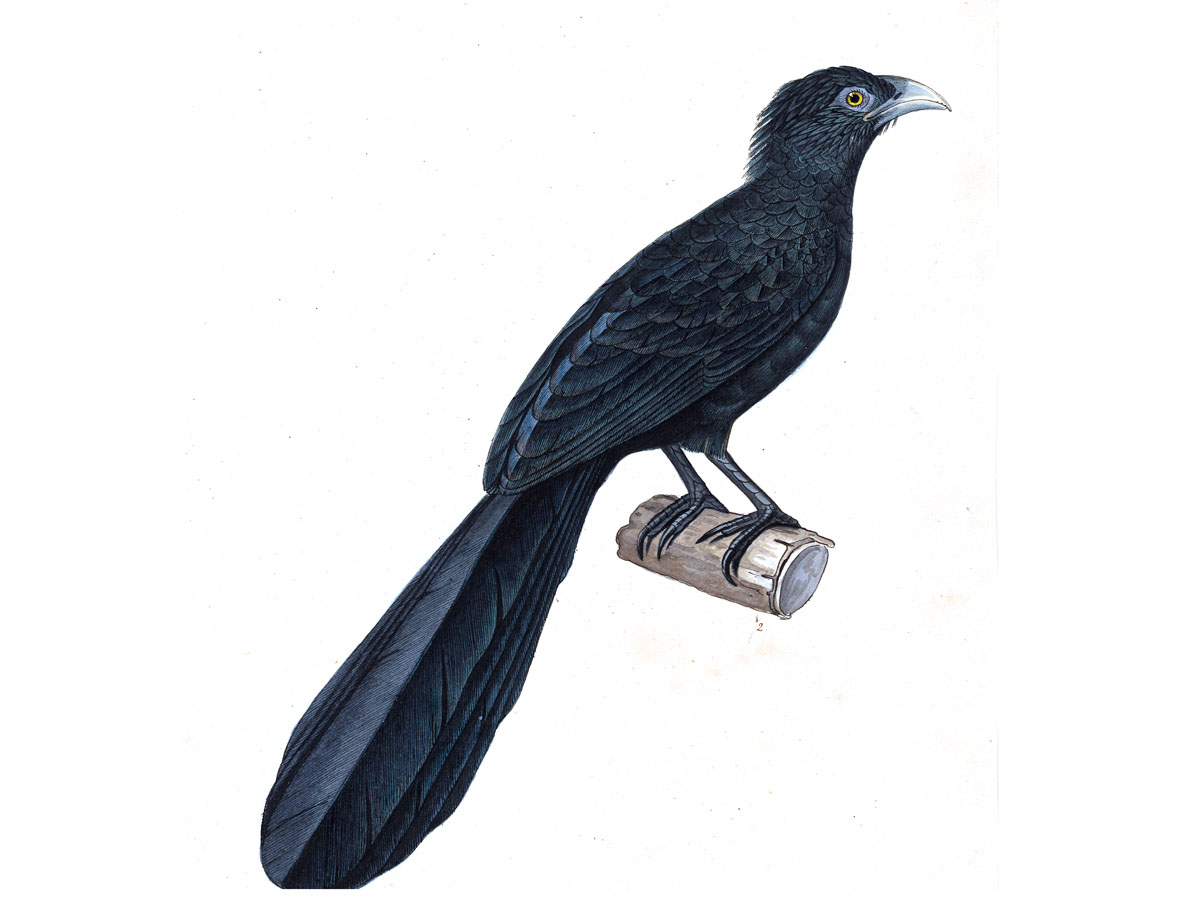
Coucal,_Green-billed Centropus chlororhynchos
Description: The green-billed coucal has a light green bill. It has mainly purple-black plumage. The wings are maroon above and black below. The long tail is dark green.
Range: Sri Lanka.
Habitat: Forest with dense undergrowth.
Diet: Snails. Also insects and vertebrates.
Conservation status: The green-billed coucal is listed as vulnerable as the numbers are declining due to habitat loss.
Image by: 1) Amila_Tennakoon 2) Kisholi_MendisRange: Sri Lanka.
Habitat: Forest with dense undergrowth.
Diet: Snails. Also insects and vertebrates.
Conservation status: The green-billed coucal is listed as vulnerable as the numbers are declining due to habitat loss.
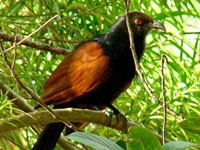
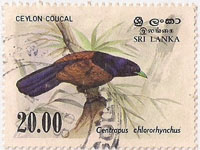
Coucal,_Lesser Centropus bengalensis
Description: The lesser coucal has mainly blackish plumage. The wings are rufous. During the breeding season it has a glossy darkish hood and upper-breast. At other times it has white shafts on its head and back. It has the longest hind-claw of any species in its genus.
Range: Asia, Indonesia, Malaysia, Philippines.
Habitat: Marshy and grassy areas that are close to forests or scrubs; also second growth forests.
Diet: Insects including grasshoppers and caterpillars. Also crickets, bettles. lizards.
Conservation status: Least concern.
Image by: 1, 2) Vijay Ismavel 3, 4) Hiyashi HakaRange: Asia, Indonesia, Malaysia, Philippines.
Habitat: Marshy and grassy areas that are close to forests or scrubs; also second growth forests.
Diet: Insects including grasshoppers and caterpillars. Also crickets, bettles. lizards.
Conservation status: Least concern.
1) Juvenile 2) Nonbreeding 3, 4) Breeding
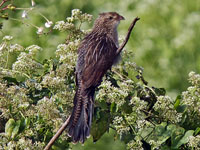
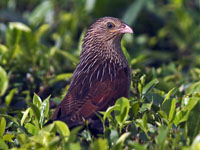

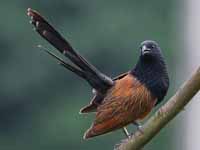
Coucal,_Lesser_Black Centropus bernsteini
Description: The lesser black coucal, also known as the black-billed coucal, has mainly dark or black plumage and a black bill. It is not easily photographed because it is shy.
Range: New Guinea and nearby islands.
Habitat: Scrub and grasses.
Conservation status: Least concern.
Image by: 1) Katerina_Tvardikova 2) Jerry Oldenettel - New GuineaRange: New Guinea and nearby islands.
Habitat: Scrub and grasses.
Conservation status: Least concern.
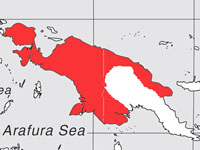
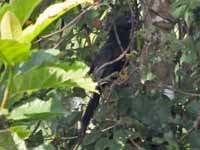
Coucal,_Madagascar Centropus toulou
Description: During breeding season the Madagascar coucal, also known as the Malagasy coucal, has mainly black with green gloss plumage. The mid and lower back are reddish-brown. At other times the head, mantle, neck, and upper-breast are brown streaked with cream.
Range: Madagscar and nearby islands.
Habitat: Dense vegetation in forests. Also grasslands, marsh, reeds.
Diet: Large insects, spiders, mollusks, invertebrates.
Conservation status: Least concern.
Image by: 1) Francesco_Veronesi 2)) Frank Vassen - Madagascar Range: Madagscar and nearby islands.
Habitat: Dense vegetation in forests. Also grasslands, marsh, reeds.
Diet: Large insects, spiders, mollusks, invertebrates.
Conservation status: Least concern.
3) Dick Daniels - Parc Tsarasaotra (open bird sanctury in Antananrivo)
1) Nonbreeding 2, 3) Breeding
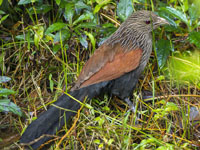


Coucal,_Pheasant Centropus phasianinus
Description: The pheasant coucal is similar in appearance to a pheasant. It mainly has black plumage with brown barring and streaks on the upperparts. In breeding season the head is mainly black. The bill and feet are black. Males have red eyes and females have orange eyes.
Range: Australasia.
Habitat: Dense forest understory, or other dense growth such as sugar cane plantations.
Diet: Insects including grasshoppers and caterpillars. Also frogs, small snakes, mice.
Conservation status: Least concern.
Image by: 1) Katerina_Tvardikova 2) Jame Niland 3) Arthur Chapman - Queenlsland, Australia 4) TattersRange: Australasia.
Habitat: Dense forest understory, or other dense growth such as sugar cane plantations.
Diet: Insects including grasshoppers and caterpillars. Also frogs, small snakes, mice.
Conservation status: Least concern.
2, 3) Nonbreeding 4) Breeding
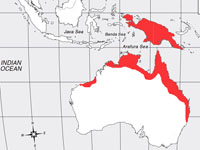
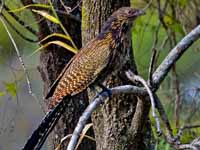

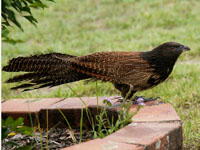
Coucal,_Philippine Centropus viridis
Description: The Philippine coucal has mainly black plumage with chestnut wings.
Range: Philippines.
Habitat: Forest; also tall grass.
Diet: Insects including caterpillars.
Conservation status: Least concern.
Image by:
1) Blake Matheson Range: Philippines.
Habitat: Forest; also tall grass.
Diet: Insects including caterpillars.
Conservation status: Least concern.
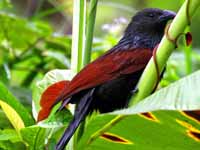
Coucal,_Pied also White-necked Coucal Centropus ateralbus
Description: The pied coucal, also known as the white-necked council, has mainly black plumage. The neck and upper breast are white. There is a small white patch on the black wings. The forehead is blackish. There are several color morphs. It is the only black-and-white coucal in its range.
Range: Bismarck Archipelago (near New Guinea).
Habitat: Forest, forest edge, and other areas with trees nearby.
Diet: Large insects, beetles, lizards, and more.
Conservation status: Least concern.
Image by: 1) Katerina_Tvardikova 2) Katerina Tvardikova 3, 4) David Cook Range: Bismarck Archipelago (near New Guinea).
Habitat: Forest, forest edge, and other areas with trees nearby.
Diet: Large insects, beetles, lizards, and more.
Conservation status: Least concern.

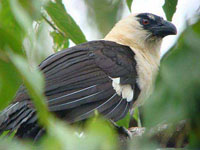
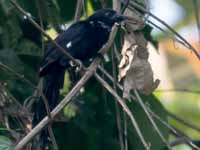
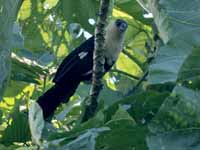
Coucal,_Rufous Centropus unirufus
Description: The rufous coucal has rufous plumage. Around the eyes there is yellow bare skin.
Range: Philippines.
Habitat: Tangled undergrowth.
Conservation status: Least concern.
Image by:
1) Lius LImchiu 2) David StangRange: Philippines.
Habitat: Tangled undergrowth.
Conservation status: Least concern.
2) specimen
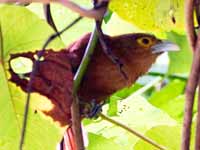
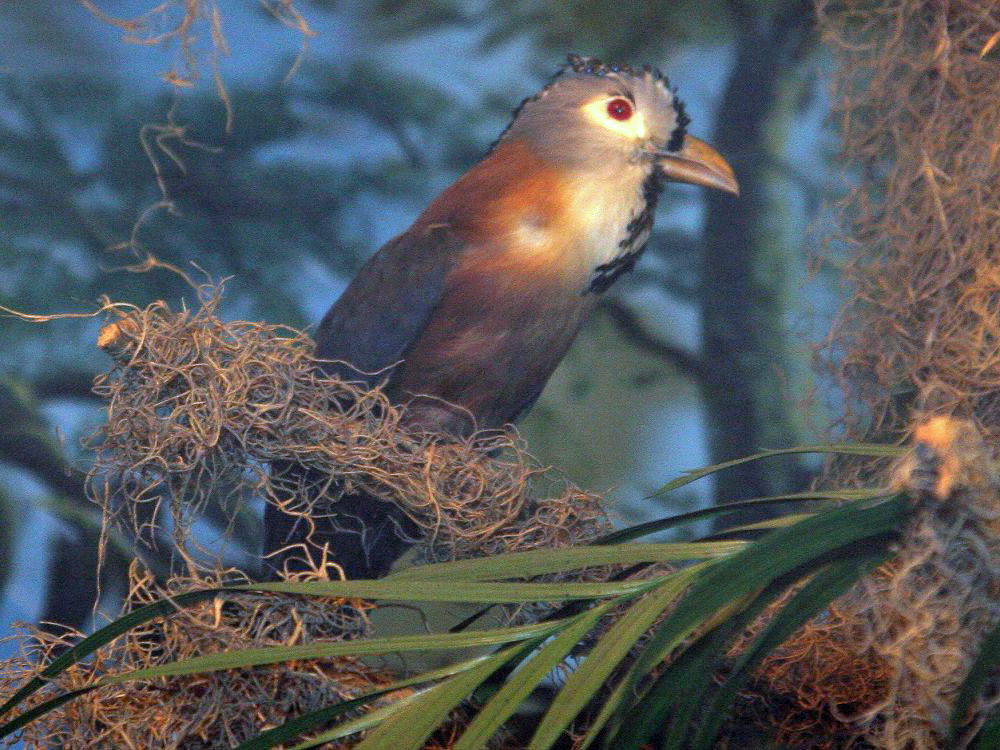
Coucal,_Senegal Centropus senegalensis
Description: The Senegal coucal has a black crown, nape, and tail. The wings are chestnut wings and the underparts, neck, plus cheeks are white.
Range: Central and southern Africa .
Habitat: Grassy habitats with trees, such as savannas.
Diet: Insects including caterpillars, small vertebrates.
Conservation status: Least concern.
Image by: 1) Frans_Vandewalle - Gambia 2) Thom Hasi - Senegal 3) tj haslam 4) Ian White - Zimbabwe 5) Charles Sharp - GambiaRange: Central and southern Africa .
Habitat: Grassy habitats with trees, such as savannas.
Diet: Insects including caterpillars, small vertebrates.
Conservation status: Least concern.

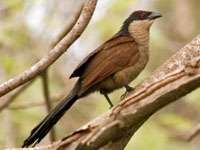
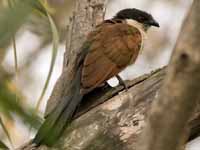
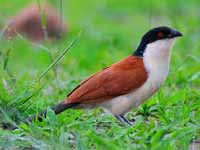

Coucal,_Short-toed Centropus rectunguis
Description: The short-toed coucal has mainly black plumage with chestnut wings. It has a black bill and feet plus red eyes.
Range: southeast Asia.
Habitat: Closed canopy forest, long grass located between 600 and 1700 meters.
Conservation status: The short-short-toed coucal is listed as vulnerable because of habitat loss.
No public domain images available.Range: southeast Asia.
Habitat: Closed canopy forest, long grass located between 600 and 1700 meters.
Conservation status: The short-short-toed coucal is listed as vulnerable because of habitat loss.
Coucal,_Sunda Centropus nigrorufus
Description: The Sunda coucal, also known as the Javan Coucal, has mainly black plumage with rufous wings. The bill and feet are black. The eyes are red.
Range: Java (Indonesia).
Habitat: Wetlands in the rainy season and grassland otherwise.
Diet: Insects including grasshoppers and caterpillars. Also frogs, small snakes, mice.
Conservation status: The Subda coucal is vulnerable because the population is small and threatened by habitat destruction. The species is also threatened by trapping.
Image by: 1) Fatih PRRange: Java (Indonesia).
Habitat: Wetlands in the rainy season and grassland otherwise.
Diet: Insects including grasshoppers and caterpillars. Also frogs, small snakes, mice.
Conservation status: The Subda coucal is vulnerable because the population is small and threatened by habitat destruction. The species is also threatened by trapping.
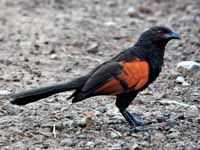
Coucal,_Violaceous Centropus violaceus
Description: The violaceous coucal, also known as the violet coucal, has black pluamage with a violet sheen. It has a black bill. The red eyes are surrounded by pale grey bare skin.
Range: Bismarck Archipelago.
Habitat: Old growth forests.
Diet: Large insects, snails, frogs.
Conservation status: The violaceous coucal is “near threatened” due to a declining population.
Image by: 1) Katerina_Tvardikova 2, 3) Nik_BorrowRange: Bismarck Archipelago.
Habitat: Old growth forests.
Diet: Large insects, snails, frogs.
Conservation status: The violaceous coucal is “near threatened” due to a declining population.

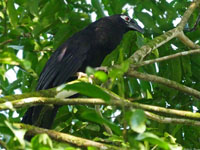
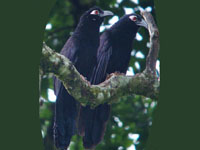
Coucal,_White-browed Centropus superciliosus
Description: The white-browed coucal has a white supercilium. It has a blackish crown, nape, bill, and feet. The back is rufous-brown and the wings are chestnut. It has a blackish rump. The black tail is glossed with green and has a white tip. The underparts are creamy-white, the eyes are red.
Range: Eastern and southern Africa.
Habitat: Areas with thick cover from undergrowth and scrub.
Diet: Insects such as grasshoppers; also lizards, small snakes, frogs, mice.
Conservation status: Least concern.
Image by: 1) adrian_valenzuela - Tanzania 2) Mathieu_Breitenstein - Kenya 3) Frederic Salein 4) Nik Borrow - UgandaRange: Eastern and southern Africa.
Habitat: Areas with thick cover from undergrowth and scrub.
Diet: Insects such as grasshoppers; also lizards, small snakes, frogs, mice.
Conservation status: Least concern.
